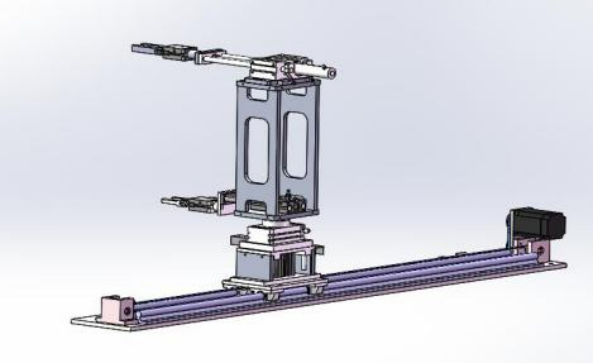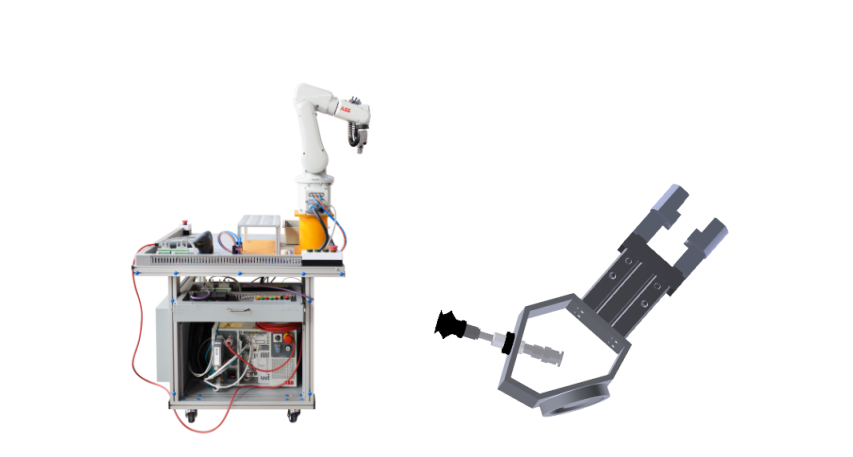Email: Gustavo@hengrytech.com Tel: +86-577-67318236
1、AC power supply: three-phase five-wire AC 380 V±10% 50Hz; single-phase three-wire AC 220 V±10% 50Hz; 2、Temperature:-10~50℃;Ambient humidity:≤90% no water bead condensation; 3、Dimensions:L×W×H=2100mm×1000mm×1600mm+1000mm×1000mm×1900mm; 4、Power consumption of the whole machine: ≤1.5 kVA;
Equipment Overview
HRA-1206R industrial robot cycle production line training equipment using 1 + 1 combined structure were installed in the aluminium alloy rail type training table by the feeding unit, processing unit, assembly unit, double layer conveying unit, sorting unit of five units, plus by the aluminium alloy rail type training table industrial robots palletising unit of the two major parts of the combination of a variety of ways of training equipment. The electrical layout adopts the drawer type, all its electrical controllers are installed in the mesh plate type drawer, this electromechanical separation format is more in line with the actual situation of the industry.
Among them, each work unit can be an independent system, but also a mechatronic system. The actuator of each unit is basically based on pneumatic actuators, but the overall movement of the conveyor unit's manipulator takes servo motor drive, precision positioning position control, the drive system has a long stroke, multi-positioning point characteristics, is a typical one-dimensional position control system. The conveyor drive of the sorting unit adopts the AC drive of three-phase asynchronous motor driven by general-purpose frequency converter to sort materials. The palletising unit uses industrial robots to inbound and outbound the materials. Robot control technology, servo position positioning control and frequency converter technology are the most widely used automation control technologies in modern industrial enterprises.
Various types of sensors are applied to the HRA-1206R equipment to determine the position of the object's movement, the state of the object's passage, the colour and material of the object, and so on. Sensor technology is one of the key technologies in mechatronics technology and is one of the prerequisites for modern industry to achieve a high degree of automation.
In terms of control, the standard configuration of HRA-1206R adopts a PLC network control scheme based on RS485 serial communication, i.e., each work unit is controlled by one PLC to undertake its control task, and the PLCs are interconnected by RS485 serial communication to achieve a distributed control method. Users can choose PLCs of different manufacturers and their supported communication modes according to their needs to form a small PLC network. Small PLC network with its simple structure and low price in small automatic production line still has a wide range of applications, in the modern industrial network communication still occupies a considerable share. On the other hand, mastering the PLC network technology based on RS485 serial communication will lay a good foundation for further study of fieldbus technology, industrial Ethernet technology and so on.
Functional characteristics
The basic functions of each unit are as follows:
1、Feeding unit
The basic function of the feed unit:
The feeding unit is the starting unit in HRA-1206R, and in the whole system, it plays the role of providing raw materials to other units in the system.
Specific Functions of the Feed Unit:
Automatically push out the workpieces to be processed (raw materials) placed in the silo onto the material table as required, so that the robot of the conveying unit can grab them and convey them to other units.
Main components of the feeding unit:
Mainly includes vertical cylinder, top material cylinder, push material cylinder, material detection sensor parts, mounting bracket platform, material detection device parts, with protection terminal unit and other components.
The working process of the feeding unit is as follows:
After the system starts, the top material cylinder extends to hold the penultimate workpiece; the push material cylinder pushes out and pushes the bottom workpiece in the material chute to the workpiece gripping position on the material table. After the workpiece in place sensor detects the workpiece in place, the push out cylinder and the top material cylinder retract one by one, and the penultimate workpiece falls to the lowest level, waiting to be pushed out. The handling station robot extends and grabs the workpiece and transports it to the processing station.
2、Processing unit
The basic function of the processing unit:
Processing unit is one of the workpiece processing units in HRA-1206R, in the whole system, it plays a role in simulating punching or stamping of workpieces sent from the conveying station.
Specific functions of the processing unit:
(1) The workpieces on the material table of the unit (the workpieces are fed by the gripping robot device of the conveying unit) are sent to the bottom of the stamping mechanism to complete a stamping process, and then sent back to the material table to be taken out by the gripping robot device of the conveying unit.
(2) The workpieces on the material table of the unit (the workpieces are sent from the assembly station by the gripping robotic device of the conveying unit) are sent to the bottom of the stamping mechanism to complete the work process of pressing the small workpieces into the large workpieces, and then sent back to the material table to be removed by the gripping robotic device of the conveying unit.
The main components of the processing unit:
Mainly includes sliding material table, analogue punch and punch press, tight manipulator, material table extending/retracting cylinder, with protection terminal unit and corresponding sensors, solenoid valve structure and other components.
The function of this station is to complete a workpiece stamping process, the process is as follows:
The robot at the handling station transports the workpiece to the material table → the material detection sensor detects the workpiece → the mechanical finger clamps the workpiece → the material table returns to the processing area under the stamping cylinder → the stamping cylinder extends downwards to stamp the workpiece → after completing the stamping action, it retracts upwards → the stamping cylinder retracts to its position → the material table extends back to its position → after the position is reached, the mechanical finger is loosened → the manipulator at the handling station extends and clips the workpiece, and transports it to the assembling station. Assembly Unit
3、Assembly unit
The basic function of the assembly unit:
The assembly unit is a unit of workpiece processing force in HRA-1206R, and in the whole system, it plays the role of assembling workpieces sent from the conveying station and feeding small workpieces.
Specific functions of the assembly unit:
The unit will feed and lift up the small black or white cylindrical workpieces in the bin.
(1) The large workpieces that have been processed from the processing unit are assembled (small workpieces are assembled into the large workpieces by robots) and then moved to the disassembling unit by the handling robots of the conveying unit.
(2) The large workpieces from the feeding unit are assembled (the small workpieces are assembled into the large workpieces by robots), and then moved to the processing unit by the handling robot of the conveying unit to carry out the stamping process.
The main components of the assembly unit:
It mainly includes feeding mechanism, rotary feeding unit, robotic assembly unit, unloading table, and terminal unit with protection.
The working process of the assembly unit is as follows:
When the handling station of the robot to transport the workpiece to the assembly station on the material table, the top material cylinder extends the top of the feeding unit penultimate workpiece; blocking cylinder retracted, so that the material groove in the lowest level of small cylindrical workpiece falls to the rotary feeding table, and then rotate the feeding unit rotates clockwise 180 degrees (right-handed), in place after the assembly of the manipulator according to the descending pneumatic hand hand claw → grasp the small cylindrical → hand claw to lift the → arm outstretched → claw descent → hand claw release action sequence, the small garden column workpiece smoothly loaded into the large workpiece, robot assembly unit reset at the same time, the rotary feeding unit counterclockwise rotation of 180 degrees (left rotation) back to the original position, the handling station manipulator extends and grab the workpiece, and transported to the material disintegration station.
4、Sorting unit
The basic function of the sorting unit:
Completion of the previous unit sent by the processed, assembled workpieces for sorting, so that different colours of workpieces from different chutes for sorting.
The main components of the sorting unit:
Mainly includes conveyor belt mechanism, three-phase motor power unit, sorting pneumatic components, sensor detection unit, high progress feedback and positioning mechanism, with protection terminal unit and other components.
Sorting unit work process is as follows:
The function of this station is to complete the sorting of assembled workpieces sent from the assembly station. When the workpiece sent from the handling station is put on the conveyor belt and detected by the photoelectric sensor at the feeding port, the frequency converter will be started and the workpiece will be sent to the sorting area, the metal workpiece will enter the first trough, the black material will enter the third trough and the white material will enter the second trough.
5、Conveying unit
The basic function of the conveying unit:
The unit through to the designated unit of the material table to accurately locate, and in the material table to grab the workpiece, the workpiece grabbed transported to the designated location and then put down the function.
The main components of the conveying unit:
Mainly includes double manipulator, linear conveyor unit, proportional transmission mechanism, multi-functional mounting bracket, synchronous wheel, synchronous belt, with protection terminal unit and other components.

The working process of the conveying unit is as follows
The function of this station is to complete the delivery of workpieces to the various work units, the system is divided into two parts of the double manipulator unit and linear displacement position precision control unit, the system is powered on, the first implementation of the return to the origin of the operation, when it reaches the origin of the position, if the system is started, the material station material station detection sensors detect the presence of a workpiece, the manipulator as a whole first lifted into place after the claw out of the hand claws in place after the claws clenched in place the claws began to clamp the claws clenched into place the claw began to Shrinking the robot as a whole will be down in place, the servo motor began to work according to the set amount of pulses to the processing station. Processing station in place after the overall lifting of the manipulator, lifting in place after the hand claw extends out of place after the overall decline in the manipulator, down in place after the workpiece has been put into the processing station material table, and then the hand claw loosening, loosening in place after the manipulator retracted, and so on the processing station processing is completed and then the workpiece will be sent to the assembly station for the size of the material assembled, assembled after the completion of the robotic grasps the material sent to the sorting station to sort, so that the double manipulator of a Processing movement process is completed. As long as the barrel is not out of material, the above process will continue. When there is a lack of material in the barrel, the robot will carry over the material, the manipulator will run to the picking position to grab the small material on the robot, and then put it into the small material barrel, and then return to the origin, when the robot carries over the material again, the manipulator will run to the picking position to grab the big material on the robot, and then put it into the big material barrel, so that the process of splitting the material will be completed until the material on the palletising table has been split up completely. Until all the materials on the palletising table are finished.
6、Robot Palletising Cell
The basic function of the robot palletising unit:
The main function of this unit is to process the sorted materials into the warehouse, and to process the materials in the warehouse by splitting and discharging them.
The main components of the robot palletising unit:
Mainly includes palletising mechanism, robot unit, hand claw fixture, pneumatic components and so on.

The working process of the robot palletising cell is as follows
The main function of this station is to process the materials in and out of the warehouse. After the system is powered on, it first performs reset and then presses the start button to reset the system, and the system starts directly after the reset is completed. When the sorting station sorting is completed, the robot will go to the corresponding chute to grab the material for storage to the corresponding material table, the first line of the material table is the metal workpiece, the second line is the white material and the third line is the black material. When the material table is full, the robot will automatically put the material into the waste box, as a waste disposal. As long as there is a lack of material in the barrel, the robot will split the material on the table and take it out of the warehouse.
V. Practical training projects
1、Organic integration of mechanical technology (including pneumatic technology), sensor technology, industrial robots, AC motor frequency control and stepping motor drive control, touch screen technology, PLC control and communication networks and other technologies, reflecting the characteristics of the production process of modern manufacturing.
★ Practical training on the installation and debugging of the feeding unit;
★Practical training for the installation and debugging of processing unit;
★Practical training for the installation and debugging of assembly units;
★Practical training for installation and commissioning of sorting units;
★Practical training for installation and commissioning of conveying units;
★Palletising unit installation and commissioning training;
★ automatic production line control installation and commissioning of practical training;
2, for teaching, according to the work process-oriented, engineering integration mode of planning teaching activities, to complete the following tasks:
(1) pneumatic system installation and commissioning project:
Select the equipment configuration of the single out of the rod cylinder, single out of the double rod cylinder, rotary cylinder and other pneumatic actuators and single-controlled solenoid reversing valve, dual-controlled solenoid reversing valve and magnetic switches, suction cups vacuum generator and other pneumatic control components, you can complete the following work tasks of pneumatic technology:
★ Installation of pneumatic direction control circuits;
★Installation of pneumatic speed control circuits;
★Installation of swing control circuits;
★Installation of pneumatic sequence control circuits;
★Installation of pneumatic manipulator devices;
★Installation and commissioning of pneumatic systems;
★Design and installation of pneumatic integrated system;
2) Installation of electrical control circuits and robots and PLC programme writing project:
Select the device configuration of PLC modules, robots, inverter modules and servo drive modules, sensors, etc., can complete the following PLC application technology work tasks:
★Three-phase motor forward and reverse control circuit connection and control programme writing;
★Connection and control programme writing for three-phase motor control circuits;
★Connection and control programme writing for motor speed control circuit;
★Connection and control programming of inverter analogue control;
★Connection and parameter setting of servo motor control circuit;
★PLC control network control technology;
★Pneumatic direction control programme writing;
★Pneumatic sequential action control programme writing;
★Pneumatic manipulator control programme writing;
★Belt conveyor control programme writing;
★Robot hardware wiring practical training;
★Robot demonstration operation practical training;
★Robot programming training;
★Robot palletising and handling training;
★Robot and PLC communication training;
★Robot simulation teaching training;
★Mechatronics equipment control programme writing;
★Automatic production line control programme writing.
3) PLC communication network installation, programming and debugging:
★PLC control technology - 485 communication technology programming and debugging
4)Electromechanical equipment installation and debugging project
Select the device configuration of electromechanical integration equipment components, PLC modules, robots, inverter modules and command switches, sensors, etc., can complete the following electromechanical equipment installation and electromechanical integration technology tasks:
★Adjustment of the coaxiality of the transmission unit;
★Mechanical installation and adjustment of feeding units;
★Mechanical installation and adjustment of processing units;
★Mechanical installation and adjustment of assembly units;
★Mechanical installation and adjustment of the sorting unit;
★Mechanical installation and adjustment of conveying units;
★Mechanical installation and adjustment of palletising units;
★Automatic production line equipment installation and commissioning.
3、This equipment is used for assessment or skills competition, can examine the vocational ability:
★Ability of assembly and adjustment of mechanical components;
★Installation and debugging ability of electromechanical equipment;
★Circuit installation ability;
★Installation and debugging ability of pneumatic system;
★Ability to use frequency converters in automatic production lines;
★Servo motor in the automatic production line ability to use;
★PLC analogue control in the automatic production line ability to use;
★Robot hardware wiring practical training;
★Robot programming practical training;
★Robot and PLC communication training;
★Ability to write control programmes for mechatronics equipment;
★Ability to install and debug automatic control systems.
★PLC network installation, programming and debugging capabilities.
★Programming and debugging ability of human-machine interface and configuration technology.
Contact: Gustavo Zhang
Phone: +86 18966252578
Tel: +86-577-67318236
Email: Gustavo@hengrytech.com
Add: Yongjia county, wenzhou city, zhejiang province ou the five-star industrial zone north street
